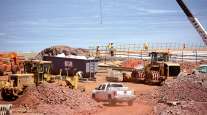Looking Back at a Century of Change as TxDOT Turns 100
TxDOT is turning 100 on April 4, the anniversary of the day Gov. James “Pa” Ferguson signed a bill creating what was then called the Texas Highway Department.
What to make of this milestone? After all, the Texas Department of Transportation at 100.2 years old will not be materially different than it was at 99.9 years old.
TxDOT is certainly making a lot of it, though, conducting what has been a couple of months of celebratory events at each of the 12,000-employee agency’s 25 geographic districts. And there’s a 100th birthday website with intriguing old photos and a superbly executed graphic timeline, called “The Long and Winding Road.” Think of the Candy Land board game, except for civil engineers rather than preschoolers. I highly recommend taking a gander.
This century of engineering and construction has included a fair measure of controversy over who got the lucrative road-building contracts and how they were awarded, where highways were built or not built, and, in the past 15 years or so, whether to charge tolls on some of those roads. I note, without excessive judgment, that the timeline graphic I referenced above includes the word “toll” just once, and even then only in this phrase: “and authorizes new non-toll highways.”
The late Texas Transportation Commission Chairman Ric Williamson, the Godfather of Toll, isn’t mentioned at all despite his outsized influence on TxDOT policy from 2001 to this day, nine years after his death. But it was a tough time for the agency.
TxDOT has had a few such rough patches over 100 years, perhaps not surprising for a department spending so much money to build such a visible and important product.
The agency, according to “Miles and Miles of Texas,” a meticulous 400-page history of the department published last fall, was born under a cloud. Ferguson was no fan of motor vehicles, it appears (he didn’t drive, authors Carol Dawson and Roger Allen Polson reported, and his preference was that speed limits remain at 10 mph), and the governor more or less had to be dragged into asking the Legislature to create a highway agency. Then, just as lawmakers were birthing this child, they simultaneously set about impeaching its Pa for sundry acts of corruption.
The saga of Ferguson and his wife, Miriam, known as “Ma” and later a Texas governor herself, would plague the state and its road agency for much of the next decade. It made for a halting start on building a system of paved roads to replace the hodgepodge of dirt paths around the state that had served horse-powered transportation. The state in 1917 had just 200,000 “registered” drivers.
The inaugural transportation commission (of Ferguson appointees) first convened in June 1917 and named a state highway engineer, who shortly thereafter proposed an 8,865-mile network of state highways. The first 20-mile section of “flexible-base” road, begun in October 1918, was constructed between Falfurrias and Encino in what is still a remote piece of South Texas. Because, well, why not there?
Anyway, before TxDOT could truly get its footing, Ma Ferguson took office in January 1925, and her disgraced husband took to attending highway commission meetings. Dawson and Polson said of this period, “the looting begins,” and that the agency went through a dark few years of “heinous activities.” Then came the stock market crash of 1929, and the several years of Depression that ensued.
Nonetheless, with a small gas tax first imposed in 1923 (1-cent-a-gallon, three-quarters for roads and a quarter for education), by 1927 the state had almost 18,000 miles of paved highways. And federal economic relief funds helped during the 1930s, along with the growing sense that another war was coming and that roads would be needed for the defense effort. With the Fergusons finally out of power and stable leadership at the top of the agency in longtime state engineer Gibb Gilchrist, the highway department in the 1930s began building the farm-to-market system of two-lane roads.
World War II stalled that effort. Texas, like the rest of the country, devoted workers and materials to the war effort rather than improving or even maintaining domestic roads. But by now, talk of a nationwide system of freeways had turned into nascent plans.
With peace came a 40-year boom for TxDOT, the real build-out of the rural roads, urban and rural expressways, a time when it became a truism that Texas roads were among the best in the nation. President Dwight Eisenhower in 1956 signed the law initiating the interstate highway system, with Uncle Sam covering 90 percent of the bill. TxDOT’s workforce soared, reaching a high of 20,500 employees in 1972.
Of course, it was also during this period that highway builders, unimpeded by any sort of environmental regulations or an appreciation of what cutting a freeway through low-income neighborhoods meant to communities, sliced Interstate 35 through East Austin and similarly wiped out African-American neighborhoods in Dallas and Houston. The price of progress, over and over, not just in Texas but in states across the country, was paid most by those least able to resist.
Then in the 1990s, with the federal interstate money all but gone, Reagan-era, anti-tax sentiments settling in and the state’s largest cities starting sustained growth and facing increasing traffic problems, TxDOT hit a cash crunch. The Legislature last raised the gas tax, to 20 cents a gallon, in 1991 (the year the department got the TxDOT name), and Congress made its most recent increase in 1993 to 18.4 cents.
Tollways, previously confined to Dallas-Fort Worth (where a toll road had been converted to free status in 1977 when the debt was paid off) and Houston, were suddenly on the table elsewhere. Enter Rick Perry as governor in late 2000, and Williamson as his appointee to the transportation commission the next year.
Writing about the next decade of toll mania would take far more space than is available here. But for awhile there, just about every major highway project on the boards, and some notable additions (4,000 miles of Perry’s dream, the Trans-Texas Corridor, which never happened), was to be a tollway. Austin went from no toll roads to, as of this writing, eight, with three more under construction.
Then came a legislative revolt against them, and finally something close to $4 billion a year in new funding for TxDOT. The agency, while still building some toll roads, has mostly returned to its pay-as-you-go roots.
The lurking issue now is not where to build roads, or how to pay for them, but about the wisdom of continued expansion of TxDOT’s almost 200,000 lane-miles of highways. Dallas officials have even talked seriously about tearing down a short stretch of freeway just east of downtown.
Most of TxDOT’s funding right now is constitutionally confined to building and maintaining roads, and it is what the agency knows how to do. But urban space for new roads is all but gone. The planet is warming. Electric and self-driving cars seem more like coming realities than science fiction. By the agency’s 200th birthday, that second “T” in TxDOT could have a much different meaning.
Distributed by Tribune Content Agency, LLC




